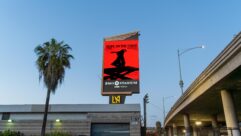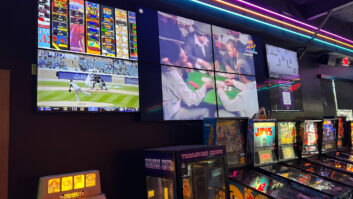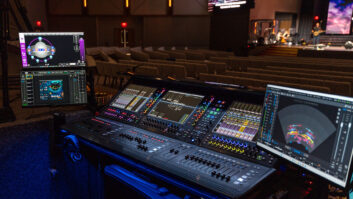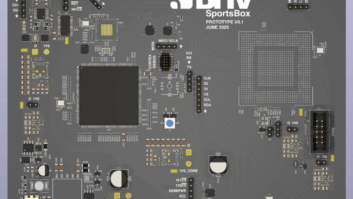Billboard Live
Dec 1, 2001 12:00 PM,
By Bruce Borgerson
THE BILLBOARD LIVE BUILDING ENCLOSES 40,000 SQUARE FEET OF interior space with an official listed capacity of 1600 partygoers and a price tag exceeding $20 million. It occupies the restored exterior of what once was the Bancroft Hotel, located just off Ocean Drive in the city’s trendy South Beach district. The reconstructed building now welcomes patrons on four levels: a separate ground-floor seafood restaurant and an expansive upper section with a main floor supporting two upper tiers opening into the common live-performance space.
Billboard Live is a privately held enterprise with its namesake entertainment magazine as the principal investor and Mitchell Chait as CEO. South Florida’s Constructa group was the site’s developer; and the free-flowing interior design was the work of New York-based interior designer Jeffrey Beers.
SYSTEMS SNAPSHOT
Billboard Live was conceived as the ultimate playground for what Chait calls the “21st-century music-based lifestyle.” Since music is central to the concept, the structure is interlaced with a network of audio, video and computer technologies.
On the audio side, the venue uses three types of systems: 70-volt distributed, auxiliary 4-ohm (for lounges and dance floors), and the main performance system. More than 110 loudspeakers (mainly from Martin Audio) are used, driven by more than 40,000 watts of amplifier power.
The video installation is equally impressive, with a complement of 11 Panasonic video projectors deployed to project images to 16 screen locations. Added video programming can be directed to strategically placed Marshall 15-inch monitors and Pioneer 50-inch screens, including the entryway videowall.
Moreover, the entire structure is fully wired for conventional broadcasting and digital webcasting. Ten broadcast panels in the facility are connected via uninterrupted cable runs (minimum two triax and four co-ax) to a master panel near the load-in dock, allowing plug-and-record by remote audio and video trucks. The performance area is wired for multiple webcams to allow for streaming webcasts of Billboard Live events.
Jed DeFilippis, Billboard Live’s vice president of studio operations and talent, devised the overall strategic plan for the A/V systems. Michael Harris of Harris Audio Systems (who fleshed out the design and consulted on equipment selection) and Paul VanPuffeln of Southern Technical Support (who led the systems integration and installation) collaborated with DeFilippis to help realize his ambitious plans.
THE PERFORMANCE SYSTEM
The Billboard Live concept revolves around live music, so the main performance system became the keystone element around which other auxiliary audio systems were developed. The idea was to keep the focus on the stage, which meant relying primarily on a point-source system, not multiple distributed sources. However, the venue’s basic layout — with high balconies set close to the stage — made this approach somewhat problematic.
“It was a bit of a challenge,” admits VanPuffeln, “because the stage comes so far out into the room and the balcony is almost directly over the front of the stage. The coverage is tricky, because the FOH stacks are sitting close to the front of the balcony. It took a lot of planning and rethinking to make it work.”
To deal with the awkward verticality of the space, the designers devised a bi-level system based on Martin Audio Wavefront components. The full-range stage stacks are comprised of four W8C three-way systems (12-, 6.5- and 1-inch) at stage right and, because of low balcony position, only three W8Cs at stage left. These project sound onto the main floor and up to the front of the first balcony. To cover the back part of the second balcony and the third-level mezzanine, six WT3 three-way systems (15-, 6.5- and 1-inch) are suspended from an overhead truss. “It’s a short, wide throw with almost everything set in a line,” notes VanPuffeln, “There’s not a whole lot of system delay involved.”
The performance system is four-way active, with tri-amplified full range plus subs on the main floor, and a separate two-way split for the overhead WT3s (passive crossover from mid to high).
Front fill is handled by four EM15 (dual 5.5-inch) systems, with sub-bass reproduction handled by four W8S (15- and 18-inch) and two WSX (18-inch) cabinets mounted on rubber isolation mats under the stage. The Martin stage monitor system has side fills left and right of WS2A (2×15-inches) and WT3 cabinets, with a WS2A and LE700A (15- and 1.5-inch) for the drummer and nine LE-12J (12- and 1.5-inch) wedges available as needed.
Selection of the Martin system was based on past experience, comparative listening tests, and consideration of expectations implicit in the Billboard name. “When we started asking around about loudspeakers, everybody wanted to get into the act,” maintains DeFilippis. “But having this name on the building meant we had to be careful. We needed something in here that would be acceptable to the touring industry at all levels.”
PROCESSING AND MIXING
The main performance system is powered by BGW GTA amplifiers on the lows and mids, with Bryston 4B amplifiers on the highs. Signal routing and master level control is via BSS Soundweb DSP systems. BSS Compact OmniDrive and MiniDrive units handle crossover and system EQ for the main and 4-ohm auxiliary systems. System amplifiers, drive signal processors, and video source and distribution equipment is housed in a master equipment room on the second level.
A pair of Innova SON Essential Live Series 48-channel recall consoles are at the front of the house. DeFilippis credits the long delay in opening the club to the digital transition at the mix position. “When we started looking for consoles in 1999, I knew the future would be digital, but the consoles available for live production at our level were just too big and expensive. I expected to go with something like a [Yamaha] PM4000 first and move up to digital later. But then Harris Audio gave me a demo of the Innova SON, and I was convinced. It’s compact, guest mixers love it, and the instant recall feature makes it a snap to set up the monitor board for multiple acts.”
THE SECONDARY SYSTEMS
Billboard Live has a number of other smaller Martin Audio systems for use as either DJ systems or for foreground music playback. At the main floor bar, four EM186 (15- and 1-inch) cabinets are placed in the four corners; they can be linked to portions of the main system for dancing or used on their own. Also on the second level, the rear of the VIP lounge has its own pair of supplemental EM76 (12- and 1-inch) speakers.
Up on the second level, the Parallel bar dance floor is surrounded by a quartet of EM76 cabinets, with low-frequency augmentation courtesy of two WS2A subwoofers. Four somewhat smaller EM57s (10- and 1-inch) carry the sound through the restaurant seating area. A portable DJ “coffin on wheels,” with equipment identical to the main-floor FOH DJ system, can be inserted into this system or plugged in on the main stage.
In other niches in the irregular space, a pair of EM15 speakers carries sound into the over-stage sky box, while a recessed bench area lower down uses two EM26s (8- and 1-inch). The Boardroom club has its own subsystem with four Martin EM26 cabinets plus two C516 ceiling speakers. Auxiliary systems are powered by BGW GTB and Millennium 2 amplifiers.
To fill all areas with music, distributed 70-volt systems are placed in the restrooms, corridors, retail spaces and in the semi-isolated circular Sobe bar. These systems employ more than 45 surface- and ceiling-mounted speakers (primarily C516s and C115s) with bass supplemented by JBL Control Contractor 19CST in-ceiling speakers. Signal routing is via Soundweb, and power is provided by BGW Millennium 2x amplifiers. Most of the signal sources originate at the main A/V-1 equipment room (the Breez restaurant has a local CD player routed through a Rane CP-64 mixer).
MANAGING MULTIPLE SYSTEMS
With so many different sub-systems and speakers all feeding into one acoustic space, careful management of sound sources, levels and directionality is crucial for maintaining a consistent feel and for avoiding cacophony. Using speakers with similar sonic signatures was a good start, but preset source and level control was essential to make the music work in every scenario.
“The BSS Soundweb units actually came in late in the game,” says VanPuffeln, “but they are at the heart of system control. All the zones in the club have separate processing and time delays set up, and the Soundwebs feed the zones in mono or stereo. Some systems have their own bi- or tri-amped systems, so we set up separate MiniDrives for them after the Soundweb.”
Presets in the Soundweb units determine which sub-systems will be on, which source they will access, and what the overall levels will be. Presets are selected via a 9010 Jellyfish remote controller placed at the FOH mix.
Again, the rule is to use the main system as a point source for live music wherever possible throughout all parts of the club. The Boardroom and Sobe Bar are isolated and therefore must use their local subsystems. But for DJ dance music or other playback, the systems switch to distributed, localized playback. System flexibility allows for special events. DeFilippis notes, “We recently had [jazz musician] Raul Midan here, and we decided during the sound check to supplement the main system with some of the auxiliary systems for a more even sound. But for rock and rap, all these systems go off. The system is very flexible.”
Local control of audio is intentionally limited. Crestron remote control devices are found in seven locations around the club, but these are essentially for video source select and playback control. Audio level control is largely restricted to FOH using the Jellyfish remote, with the exception of passive attenuators on the 70-volt systems at key locations.
SYSTEM INSTALLATION…FINALLY!
Even for the leisurely pace of South Florida, it took a long time to realize the Billboard Live concept. Chait and the developers first forecasted an April 1999 opening. But contractor problems and permit bottlenecks pushed back the opening date by more than two years.
On the up side, the long delays gave the A/V systems team ample time to refine their designs and to make adjustments during construction. “It was a challenge in terms of size and implementation,” says VanPuffeln, “but we had plenty of time.” And there were only a few changes to the plan: “We originally planned to run a 56-pair Whirlwind snake to FOH mix, but we ended up with a single pair of co-ax for the Innova SON.”
Because of the acoustical complexity of the space, EASE modeling was not used as part of the design process. Instead, the designers relied on experience, treating balcony fronts and the ceiling with deadening materials to minimize destructive interference. “We had a TEF system up there to check it out,” says VanPuffeln, “but there wasn’t much time alignment to do on the overall system because everything lined up pretty well as a point source at stage front. For time alignments for the cabinets, we used specifications from Martin.”
BREAKING THE MOLD
Now that it’s complete, many industry observers agree that Billboard Live set a new standard for technology in this type of venue. “This is the most complete live venue of its size that, as far as I know, anybody has ever been allowed to do,” says Michael Harris of Harris Audio. “Often in installations of this type, you’ll see compromises, but not here. It’s nice to be able to do everything right at every stage of the game.”
From his viewpoint in operations, DeFilippis is delighted. “We had a lot of time and made a lot of changes,” he notes, “but now we have something unique that really works. Major touring acts can come in and use everything that we have. Acts will bring in their favorite effects and maybe consoles, but I don’t think anybody will say, ‘Let’s go rent some other stuff because this isn’t up to par.’”
The club opened to the public on September 8. Opening-night headliners were Celia Cruz, Blu Cantrell, Damian Marley and Rabanes, and DJ Jellybean Benitez. A crowd estimated at over 3000 packed the club, terrace and surrounding sidewalks. “We had a great reaction from the crowd,” exults DeFilippis. “We had DJs outside on the terrace and grand opening hoopla like marching bands, elephants and monkeys, an unveiling of the sign and awards to the owner. The music was going, champagne was flowing…it was great.”
Even after the heady elation of the grand opening faded, DeFilippis remained confident that Billboard Live would break new ground in the arena of entertainment technologies.
“I’ve had experience with several very good clubs, but this is better than anything I’ve seen. Everything works together: the architecture, the finishes, the colors, the sound…even though some things were developed on the fly, like the illuminated glass floors, the fiber optic entrances and the water features. It was an ongoing, organic design-build. Sometimes in these circumstances, things don’t work out the way you expect. But we made it happen, and it blows me away.”
But when asked if he would forego the luxury of an extended design-build process for a timelier opening, DeFilippis demurs, “I don’t know. Maybe I’d just as soon have it done on schedule. But at least we got it open…finally!”
Bruce Borgerson is principal of Wavelength Communications in Ashland, Oregon.
A Quick Tour of Billboard Live
The upper portion of Billboard Live has three levels within one structure. Patrons enter the main stage level through a dazzling entry corridor with a huge mirror, colored lighting effects and four 50-inch Pioneer screens arranged in a videowall. Proceeding into the main performance space, visitors can split off toward the open-space bars of the VIP area. A 32×23-foot stage occupies the far corner, while looming overhead is the million-dollar chandelier — a truss loaded with lights, dimmers and video screens that can be raised or lowered by 25 one-ton motors.
On the first level up from the main floor is Parallel, an upscale restaurant and bar with a capacity of about 500. An expansive outdoor terrace on this level opens out over Ocean Drive. On the mezzanine is another bar and an eagle’s eye view of the stage. This third level also houses the Boardroom, a members-only club-within-a-club.
The ground floor of the building houses a separate seafood restaurant, Breez. Although an integral part of the Billboard Live enterprise, Breez is not directly connected to the performance space above.
FOR MORE INFORMATION
BGW
www.bgw.com
Circle 200 on Reader Service Card
Bryston
www.bryston.ca
Circle 201 on Reader Service Card
BSS Audio
www.bss.co.uk
Circle 202 on Reader Service Card
Crestron
www.crestron.com
Circle 203 on Reader Service Card
Gold Line/TEF
www.gold-line.com
Circle 204 on Reader Service Card
Innova SON
www.innovason.com
Circle 205 on Reader Service Card
JBL
www.jblpro.com
Circle 206 on Reader Service Card
Marshall
www.mars-cam.com
Circle 207 on Reader Service Card
Martin Audio
www.martin-audio.com
Circle 208 on Reader Service Card
Panasonic
www.panasonic.com/proaudio
Circle 209 on Reader Service Card
Pioneer
www.pioneerelectronics.com
Circle 210 on Reader Service Card
Rane
www.rane.com
Circle 211 on Reader Service Card
Whirlwind
www.whirlwindusa.com
Circle 212 on Reader Service Card
Yamaha
www.yamaha.com
Circle 213 on Reader Service Card










